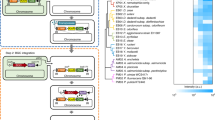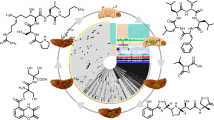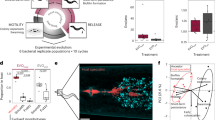Abstract
Biosynthetic gene clusters (BGCs) bridging genotype and phenotype continuously evolve through gene mutations and recombinations to generate chemical diversity. Phenazine BGCs are widespread in bacteria, and the biosynthetic mechanisms of the formation of the phenazine structural core have been illuminated in the last decade. However, little is known about the complex phenazine core-modification machinery. Here, we report the diversity-oriented modifications of the phenazine core through two distinct BGCs in the entomopathogenic bacterium Xenorhabdus szentirmaii, which lives in symbiosis with nematodes. A previously unidentified aldehyde intermediate, which can be modified by multiple enzymatic and non-enzymatic reactions, is a common intermediate bridging the pathways encoded by these BGCs. Evaluation of the antibiotic activity of the resulting phenazine derivatives suggests a highly effective strategy to convert Gram-positive specific phenazines into broad-spectrum antibiotics, which might help the bacteria–nematode complex to maintain its special environmental niche.
This is a preview of subscription content, access via your institution
Access options
Access Nature and 54 other Nature Portfolio journals
Get Nature+, our best-value online-access subscription
$29.99 / 30 days
cancel any time
Subscribe to this journal
Receive 12 print issues and online access
$259.00 per year
only $21.58 per issue
Buy this article
- Purchase on Springer Link
- Instant access to full article PDF
Prices may be subject to local taxes which are calculated during checkout





Similar content being viewed by others
Data availability.
All data generated or analyzed in this study are available within the article and its Supplementary Information files.
References
Lawrence, J. Selfish operons: the evolutionary impact of gene clustering in prokaryotes and eukaryotes. Curr. Opin. Genet. Dev. 9, 642–648 (1999).
Mao, D., Bushin, L. B., Moon, K., Wu, Y. & Seyedsayamdost, M. R. Discovery of scmR as a global regulator of secondary metabolism and virulence in Burkholderia thailandensis E264. Proc. Natl Acad. Sci. USA 114, E2920–E2928 (2017).
Wang, Z. & Cirino, P. C. New and improved tools and methods for enhanced biosynthesis of natural products in microorganisms. Curr. Opin. Biotechnol. 42, 159–168 (2016).
Koonin, E. V., Makarova, K. S. & Aravind, L. Horizontal gene transfer in prokaryotes: quantification and classification. Annu. Rev. Microbiol. 55, 709–742 (2001).
Keeling, P. J. & Palmer, J. D. Horizontal gene transfer in eukaryotic evolution. Nat. Rev. Genet. 9, 605–618 (2008).
Fischbach, M. A., Walsh, C. T. & Clardy, J. The evolution of gene collectives: how natural selection drives chemical innovation. Proc. Natl Acad. Sci. USA 105, 4601–4608 (2008).
Medema, M. H., Cimermancic, P., Sali, A., Takano, E. & Fischbach, M. A. A systematic computational analysis of biosynthetic gene cluster evolution: lessons for engineering biosynthesis. PLoS Comput. Biol. 10, e1004016 (2014).
Cai, X. et al. Entomopathogenic bacteria use multiple mechanisms for bioactive peptide library design. Nat. Chem. 9, 379–386 (2017).
Yoshikuni, Y., Ferrin, T. E. & Keasling, J. D. Designed divergent evolution of enzyme function. Nature 440, 1078–1082 (2006).
Nakashima, Y. et al. Structure function and engineering of multifunctional non-heme iron dependent oxygenases in fungal meroterpenoid biosynthesis. Nat. Commun. 9, 104 (2018).
Pan, G. et al. Discovery of the leinamycin family of natural products by mining actinobacterial genomes. Proc. Natl Acad. Sci. USA 114, E11131–E11140 (2017).
Wolpert, M., Gust, B., Kammerer, B. & Heide, L. Effects of deletions of mbtH-like genes on clorobiocin biosynthesis in Streptomyces coelicolor. Microbiology 153, 1413–1423 (2007).
Laursen, J. B. & Nielsen, J. Phenazine natural products: biosynthesis, synthetic analogues, and biological activity. Chem. Rev. 104, 1663–1685 (2004).
Guttenberger, N., Blankenfeldt, W. & Breinbauer, R. Recent developments in the isolation, biological function, biosynthesis, and synthesis of phenazine natural products. Bioorg. Med. Chem. 25, 6149–6166 (2017).
Blankenfeldt, W. & Parsons, J. F. The structural biology of phenazine biosynthesis. Curr. Opin. Struct. Biol. 29, 26–33 (2014).
Mentel, M. et al. Of two make one: the biosynthesis of phenazines. ChemBioChem 10, 2295–2304 (2009).
Price-Whelan, A., Dietrich, L. E. & Newman, D. K. Rethinking ‘secondary’ metabolism: physiological roles for phenazine antibiotics. Nat. Chem. Biol. 2, 71–78 (2006).
Mavrodi, D. V., Blankenfeldt, W. & Thomashow, L. S. Phenazine compounds in fluorescent Pseudomonas spp. biosynthesis and regulation. Annu. Rev. Phytopathol. 44, 417–445 (2006).
Rui, Z. et al. Insights into a divergent phenazine biosynthetic pathway governed by a plasmid-born esmeraldin gene cluster. Chem. Biol. 19, 1116–1125 (2012).
Wu, C. et al. Leucanicidin and endophenasides result from methyl-rhamnosylation by the same tailoring enzymes in Kitasatospora sp. MBT66. ACS Chem. Biol. 11, 478–490 (2016).
Lengyel, K. et al. Description of four novel species of Xenorhabdus, family Enterobacteriaceae: Xenorhabdus budapestensis sp. nov., Xenorhabdus ehlersii sp. nov., Xenorhabdus innexi sp. nov., and Xenorhabdus szentirmaii sp. nov. Syst. Appl. Microbiol. 28, 115–122 (2005).
Weber, T. et al. antiSMASH 3.0—a comprehensive resource for the genome mining of biosynthetic gene clusters. Nucleic Acids Res. 43, W237–W243 (2015).
Tobias, N. J. et al. Natural product diversity associated with the nematode symbionts Photorhabdus and Xenorhabdus. Nat. Microbiol. 2, 1676–1685 (2017).
Leisch, H., Morley, K. & Lau, P. C. K. Baeyer−Villiger monooxygenases: more than just green chemistry. Chem. Rev. 111, 4165–4222 (2011).
White, S. W., Zheng, J., Zhang, Y.-M. & Rock, C. O. The structural biology of type II fatty acid biosynthesis. Annu. Rev. Biochem. 74, 791–831 (2005).
Yu, S. et al. Atomic resolution structure of EhpR: phenazine resistance in Enterobacter agglomerans Eh1087 follows principles of bleomycin/mitomycin C resistance in other bacteria. BMC Struct. Biol. 11, 33 (2011).
Giddens, S. R., Feng, Y. J. & Mahanty, H. K. Characterization of a novel phenazine antibiotic gene cluster in Erwinia herbicola Eh1087. Mol. Microbiol. 45, 769–783 (2002).
Myhren, L. E. et al. Iodinin (1,6-dihydroxyphenazine 5,10-dioxide) from Streptosporangium sp. induces apoptosis selectively in myeloid leukemia cell lines and patient cells. Mar. Drugs 11, 332–349 (2013).
Turner, J. M. & Messenger, A. J. in Advances in Microbial Physiology Vol. 27 (eds A. H. Rose & D. W. Tempest) 211–275 (Academic Press, 1986).
Yagishita, K. Production of phenazine compounds by Streptomyces griseoluteus. J. Antibiot. A 13, 83–96 (1960).
Ghoul, M., Bernard, T. & Cormier, M. Evidence that Escherichia coli accumulates glycine betaine from marine sediments. Appl. Environ. Microbiol. 56, 551–554 (1990).
Dym, O. & Eisenberg, D. Sequence-structure analysis of FAD-containing proteins. Protein Sci. 10, 1712–1728 (2001).
Bode, E. et al. Biosynthesis and function of simple amides in Xenorhabdus doucetiae. Environ. Microbiol. 19, 4564–4575 (2017).
Bode, E. et al. Simple “on-demand” production of bioactive natural products. ChemBioChem 16, 1115–1119 (2015).
Chatterjee, S. et al. Phencomycin, a new antibiotic from a Streptomyces species HIL Y-9031725. J. Antibiot. 48, 1353–1354 (1995).
Rix, U. et al. The dynamic structure of jadomycin B and the amino acid incorporation step of its biosynthesis. J. Am. Chem. Soc. 126, 4496–4497 (2004).
Colosimo, D. A. & MacMillan, J. B. Detailed mechanistic study of the non-enzymatic formation of the discoipyrrole family of natural products. J. Am. Chem. Soc. 138, 2383–2388 (2016).
Vidoudez, C. & Pohnert, G. Growth phase-specific release of polyunsaturated aldehydes by the diatom Skeletonema marinoi. J. Plankton Res. 30, 1305–1313 (2008).
Brameyer, S., Kresovic, D., Bode, H. B. & Heermann, R. Dialkylresorcinols as bacterial signaling molecules. Proc. Natl Acad. Sci. USA 112, 572–577 (2015).
Mori, T. et al. Structural insight into the enzymatic formation of bacterial stilbene. Cell Chem. Biol. 23, 1468–1479 (2016).
Bretschneider, T. et al. A ketosynthase homolog uses malonyl units to form esters in cervimycin biosynthesis. Nat. Chem. Biol. 8, 154–161 (2012).
Proschak, A. et al. Biosynthesis of the insecticidal xenocyloins in Xenorhabdus bovienii. ChemBioChem 15, 369–372 (2014).
Kwon, H.-J. et al. C-O bond formation by polyketide synthases. Science 297, 1327–1330 (2002).
Qiu, X. et al. Crystal structure of β-ketoacyl-acyl carrier protein synthase III: a key condensing enzyme in bacterial fatty acid biosynthesis. J. Biol. Chem. 274, 36465–36471 (1999).
Lin, S., Van Lanen, S. G. & Shen, B. A free-standing condensation enzyme catalyzing ester bond formation in C-1027 biosynthesis. Proc. Natl Acad. Sci. USA 106, 4183–4188 (2009).
Imamura, N. et al. New anticancer antibiotics pelagiomicins, produced by a new marine bacterium Pelagiobacter variabilis. J. Antibiot. 50, 8–12 (1997).
Singh, M. P. et al. Biological and mechanistic activities of phenazine antibiotics produced by culture LL-14I352. J. Antibiot. 50, 785–787 (1997).
Burger, R. M. Cleavage of nucleic acids by bleomycin. Chem. Rev. 98, 1153–1169 (1998).
Nikaido, H. & Takatsuka, Y. Mechanisms of RND multidrug efflux pumps. Biochim. Biophys. Acta 1794, 769–781 (2009).
Wang, Y., Luo, Q., Zhang, X. & Wang, W. Isolation and purification of a modified phenazine, griseoluteic acid, produced by Streptomyces griseoluteus P510. Res. Microbiol. 162, 311–319 (2011).
Moon, S. H. et al. Novel linear lipopeptide paenipeptins with potential for eradicating biofilms and sensitizing gram-negative bacteria to rifampicin and clarithromycin. J. Med. Chem. 60, 9630–9640 (2017).
Fischbach, M. A. & Clardy, J. One pathway, many products. Nat. Chem. Biol. 3, 353–355 (2007).
Clemons, P. A. et al. Quantifying structure and performance diversity for sets of small molecules comprising small-molecule screening collections. Proc. Natl Acad. Sci. USA 108, 6817–6822 (2011).
Shi, Y.-M. & Bode, H. B. Chemical language and warfare of bacterial natural products in bacteria-nematode-insect interactions. Nat. Prod. Rep. 35, 309–335 (2018).
Hadjithomas, M. et al. IMG-ABC: a knowledge base to fuel discovery of biosynthetic gene clusters and novel secondary metabolites. mBio 6, e00932 (2015).
Fu, C., Donovan, W. P., Shikapwashya-Hasser, O., Ye, X. & Cole, R. H. Hot Fusion: an efficient method to clone multiple DNA fragments as well as inverted repeats without ligase. PLoS ONE 9, e115318 (2015).
Brachmann, A. O. et al. A type II polyketide synthase is responsible for anthraquinone biosynthesis in Photorhabdus luminescens. ChemBioChem 8, 1721–1728 (2007).
Studier, F. W. Protein production by auto-induction in high-density shaking cultures. Protein Expr. Purif. 41, 207–234 (2005).
Letunic, I. & Bork, P. Interactive tree of life (iTOL)v3: an online tool for the display and annotation of phylogenetic and other trees. Nucleic Acids Res. 44, W242–W245 (2016).
Matuschek, E., Brown, D. F. J. & Kahlmeter, G. Development of the EUCAST disk diffusion antimicrobial susceptibility testing method and its implementation in routine microbiology laboratories. Clin. Microbiol. Infect. 20, O255–O266 (2014).
Heinrich, A. K., Glaeser, A., Tobias, N. J., Heermann, R. & Bode, H. B. Heterogeneous regulation of bacterial natural product biosynthesis via a novel transcription factor. Heliyon 2, e00197 (2016).
Acknowledgements
The authors are grateful to T. A. Wichelhaus from Universitätsklinikum Frankfurt for the help with antibiotic susceptibility testing and the following colleagues from Goethe Universität Frankfurt: K. A. J. Bozhüyük for constructive discussion, K. M. Pos for providing the E. coli efflux pump mutant strains, and Y. Kopp and S. Mauer for the initial analysis of the phenazine biosynthesis in X. szentirmaii. This work was supported by the LOEWE program of the state of Hesse (LOEWE Schwerpunkt MegaSyn and LOEWE Zentrum TBG). Y.-M.S. is supported by a Postdoctoral Research Fellowship from the Alexander von Humboldt Foundation.
Author information
Authors and Affiliations
Contributions
Y.-M.S. and H.B.B. conceived the project and wrote the paper. All experiments were performed by Y.-M.S., except initial analysis and heterologous expression of the gene clusters performed by A.O.B. RNA sequencing was performed by M.W. and N.J.T. and G. mellonella injection was performed by N.N. Y.-M.S., N.J.T., and H.B.B. discussed the results and commented on the manuscript.
Corresponding author
Ethics declarations
Competing interests
The authors declare no competing interests.
Additional information
Publisher’s note: Springer Nature remains neutral with regard to jurisdictional claims in published maps and institutional affiliations.
Supplementary information
Supplementary Information
Supplementary Tables 1–6, Supplementary Figures 1–27
Supplementary Note
Synthetic Procedures
Rights and permissions
About this article
Cite this article
Shi, YM., Brachmann, A.O., Westphalen, M. et al. Dual phenazine gene clusters enable diversification during biosynthesis. Nat Chem Biol 15, 331–339 (2019). https://doi.org/10.1038/s41589-019-0246-1
Received:
Accepted:
Published:
Issue Date:
DOI: https://doi.org/10.1038/s41589-019-0246-1



